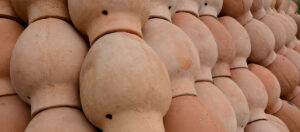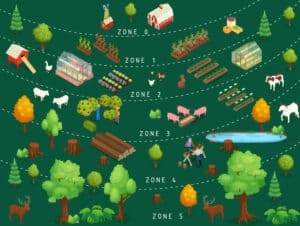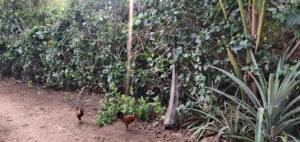Good permaculture design involves developing ways of doing more with less. It involves seeking elements for inclusion in a system that fulfills as many functions as possible and combining elements to create spaces and systems that can do more through holistic design.
In permaculture circles, we often talk about these things as stacking functions.
What Does ‘Stacking Functions’ Mean?
When we talk about stacking functions in permaculture design, we are talking about incorporating elements and creating spaces that do as much as possible – fulfilling multiple functions, filling multiple niches, and providing multiple yields.
Typically, we talk about stacking functions in two contexts. First of all, we talk about stacking functions by choosing multi-functional elements. Secondly, we also talk about stacking functions within spaces through the combination of multi-functional elements to create holistic functioning spaces that fulfil as many functions as possible.
Multi-Functional Elements
The elements within a permaculture design might include man-made elements such as rainwater harvesting features, composting systems, buildings or garden structures, pathways, etc…
Of course, the elements also include the plants that we choose to grow.
When we select items carefully, looking at what each one can provide, its characteristics, and the things it can provide, we can make sure that we choose elements that deliver as many benefits and fulfill as many functions as possible.
It is also important to make sure that within any design, we have multiple elements that fulfill each individual function that we require.
Multi-Functional Spaces (Holistic Design)
Once we understand the functions and yields provided by individual elements, however, there is still another further step to take.
To stack functions effectively within a system, we need to consider not only each element in isolation but also how we can integrate different features to make the most of our space and create holistic designs.
Our goal is to integrate elements in such a way that together, they provide more than each of the individual elements could provide on their own. Stacking the functions of multiple elements can allow us to do so in effective and efficient ways.
Why Stacking Functions is Important in Permaculture Design
Incorporating plenty of diversity and building redundancy into our designs for our homes, gardens, farms, and societal systems makes them more resilient – increasing stability and making sure that our systems stand the test of time.
Stacking functions is one element in increasing diversity, since the more an element or space can do, the more beneficial interactions we can generate. And the more diverse and abundant these beneficial interactions, the more effective, efficient, resilient, and sustainable our systems will be.
When we make sure that every element has multiple functions, and that we create holistic multi-functional designs, we not only help to ensure the long-term health of the system itself but also maximize the yields that we ourselves can derive from such systems.
Systems Analysis in Permaculture Design
In order to begin stacking functions, we first have to analyze the different elements that might already be present within a system and those that we might include within a design.
Seeking Functions in Individual Elements
This involves looking at the inputs, outputs, and characteristics of individual elements, and contextualizing those within the strengths, weaknesses, opportunities, and challenges of a site and situation.
Inputs are those things that we put into an element, or that it requires for it to fulfill a particular function.
Outputs are the things that come from an element – yields and byproducts of its functions.
The characteristics of an element are those things, intrinsic and extrinsic properties, that make it what it is. The characteristics of something include those things that determine how it works, and the functions it can fulfill, and well as those things that determine where it is best positioned and its needs.
By looking at the inputs, outputs, and characteristics of elements within a design, and seeing where these match up with the strengths, weaknesses, opportunities, and challenges inherent in a location or situation, we can begin to build up a picture of the functions within a design that a certain element can fulfill – either in generating its own yields or enabling yields within the design as a whole.
Stacking Functions in Holistically Designed Systems
Beyond looking at individual elements, we can then work to determine how best to combine elements, each of which fulfills multiple functions, to stack functions within the space. We can take a holistic approach and design from patterns to details to achieve our goals.
The permaculture concepts of sectors and zoning help us to begin to determine the best layout for a space, and systems analysis helps us begin to appreciate the complex ways in which the different elements interact.
By looking at the inputs, outputs and characteristics of elements within this broader context, we can begin to see where the outputs of one element become the input for another, and how the characteristics of one element can help meet the needs of the next.
This helps us to identify functions within the system, and develop combinations of multi-functional elements within a space to make the most of both space and time and do more with less.
Examples of Stacking Functions in Permaculture Design
In order to understand this a little more, let’s take a look at some examples of stacking functions in permaculture design.
Elements With Multiple Functions and Multiple Elements for Each Function
First of all, let’s take a look at some examples that show how we can make sure that we choose elements that have multiple functions, and make sure that we have multiple elements that fulfill each of the functions we identify.
Plants
Plants are of course very important elements in any farm or garden design. All plants suited to place can be useful, of course. But some plants really are keystone species that can fulfill a wide range of roles and provide a wide range of yields.
Trees are often important within permaculture designs. So to illustrate this point let’s take a look at an apple tree – one great example of a multi-functional element in a permaculture design.
By looking at the characteristics and outputs of an apple tree, we can see that it fulfills many functions. An apple tree:
- Provides an edible yield (fruit).
- Has medicinal and cosmetic uses.
- Provides pectin for use in jams etc..
- It can sometimes be used as a fodder crop for some livestock.
- Provides fine-grained wood used for woodworking and craft.
- And gives us pruned wood that can be mulched, or used as fuel.
- Caters to pollinators in the spring when in blossom.
- Creates habitat for and can feed a wide range of wildlife.
- Sequesters carbon, helping to tackle our climate crisis.
- Provides shade, privacy, play-space etc. for humans nearby.
- Drops leaves in autumn (fall) to return nutrients to the soil and build humus.
Of course, for each of these functions, we can also incorporate other plants that fulfill the same functions in similar or somewhat different ways – to build resiliency and even redundancy into a system.
Livestock
Livestock might also be multi-functional elements included within permaculture design. Let’s take as an example chickens. Chickens can fulfill a range of functions; for example, they might:
- Provide food (eggs, potentially meat/ stock etc…).
- Give us feathers (which have a range of uses).
- Produce manure (add fertility).
- Help in integrated pest management in organic growing.
- Help to ’till’ an area for cultivation.
- Clean up remnants of annual crops.
- Clean up/ spread manure of other livestock in rotation.
- Alert to the presence of a threat or predator (alarm system).
- Produce heat in their coop (potentially of benefit in winter).
Of course, chickens are only one example of livestock that can be integrated on a range of scales. And we can make sure we don’t put all of our eggs in one basket by keeping multiple species that can fulfill some or all of the functions above and contribute other things of their own.
Infrastructure
When it comes to buildings, fencing, pathways and other infrastructure elements in a permaculture design, simple solutions can sometimes be the optimal ones. However, it can be beneficial to think about how something designed to predominantly fulfill just one simple function can actually fulfill a much greater number of roles.
To give one simple example, a fence might meet our need for privacy. But we might instead, replace that fence in a design with a hedgerow, trellis climbing plants, or other elements that can fulfill this function while also meeting a range of other needs.
Stacking Functions in Integrated Design
Of course, in permaculture design, we would not just plant an apple tree (or another tree) alone. We would also stack plants and functions, creating guilds and layered food forest planting schemes that help us make sure that we have plenty of other plants that also fulfill these functions, as well as adding other functions of their own.
We would not just incorporate livestock elements that provide for multiple needs, we would also integrate livestock with trees and other elements in agroforestry systems or other multi-functional designs.
We would not just include useful infrastructure elements, but would also think carefully about how we can combine these elements to truly make the most of space and time, capitalizing on strengths and opportunities.
Functioning Ecosystems & Polyculture Planting
Remember that apple tree with its many functions? Well, within permaculture design, we can use this as a key multi-functional element at the heart of a fruit tree guild. And can then combine this guild within a broader forest garden scheme. Apple trees can also be integrated within agroforestry systems that combine arable crops or livestock elements.
By thinking about the system as a whole, we can not only benefit from the apple tree, but also help ensure that it remains healthy and provides yields that are as high as possible by carefully considering how we combine the plants in our gardens. Our goal should be to create functioning ecosystems and food-producing spaces that mimic natural ecosystems.
An apple tree guild is an example of polyculture planting. Polyculture planting is an excellent example of the ways in which combining plants (elements) in specific ways can lead to the system as a whole fulfilling more functions, and making more of the space and time available. This is the ultimate synthesis and demonstration of the concept of companion planting.
I have a number of apple trees in my forest garden, along with plum and cherry trees. Below the apple trees, I have planted layered planting. Here are some of the plants included along with their functions:
- Elaeagnus ssp. (nitrogen fixation, mulch & composting material, pollinator attraction, edible yields)
- Ribes ssp. (gooseberry, blackcurrant, redcurrant) (edible yield, protection – spiny plant (gooseberry), pollinator attraction, wildlife habitat & food for wildlife)
- Comfrey (dynamic accumulator, mulch plant, pollinator attractant, medicinal plant)
- Foxgloves (dynamic accumulator, said to help apple trees fruit well, pollinator attractant, visual appeal )
- Fireweed (edible yields, pollinator attractant, visual appeal)
- Nettles (edible yields, medicinal, fibre plant, wildlife attractant, dynamic accumulator)
- Rumex ssp. (sorrels) (edible, medicinal, dye plant, groundcover)
- Blitum bonus-henricus (Good King Henry) (edible – perennial vegetable and historic grain crop, staple crop- balanced carb, minor medicinal uses, dye plant.)
- Mentha (mints) (edible, medicinal, groundcover, pollination, pest-control)
- Daffodils (spring ephemeral, grass-suppressing, pollinator attraction)
Just as each plant within a natural functioning ecosystem contributes to the whole, so too do all the elements in a fruit tree guild or polyculture planting scheme work together, having been chosen with careful thought as to their inputs, outputs, and characteristics.
Yield can be higher and results better when we combine multi-functional elements wisely to create spaces and systems by stacking functions.
Even when one element of such a system fails, the built-in redundancy means that we can often still obtain a worthwhile yield. And with rich biodiversity in planting, the system is far more likely to endure.
Integrated Livestock Schemes
Once we realize the functions of a particular element such as chickens, we can find ways to integrate them into broader systems.
For example, placing chickens to forage an area around a fenced-off annual garden or food forest, they can help keep pests at bay – helping you combat a slug problem for example.
A chicken ‘moat’ is a permaculture idea that involves creating a chicken run that entirely surrounds an area of a garden. This is often shared as an example of ‘stacking functions’, where together, functions combine to create holistic designs that offer multiple benefits.
One other idea involving chickens relates to placing their coop adjacent to a greenhouse. Within the combined greenhouse and coop structure, the chickens’ body heat can warm the inside of the structure, and chickens provide manure for fertility and keep pests at bay. While the greenhouse (on the sunnier side) provides solar gain.
Another example of stacking functions in holistic design is when a chicken coop is placed above a pond, stocked with fish, which can be part of a rustic aquaponics system.
Chickens can also be integrated into rotational grazing through an agroforestry system alongside and following other livestock species. Mobile chicken coops or chicken tractor systems are often used.
Stacking Functions in Infrastructure
There are numerous well-known and more innovative ways to stack functions when it comes to buildings and infrastructure such as fencing, paths, trellises, water systems, etc. in a permaculture design.
The key lies in finding synergy and exploring ideas with a view to the bigger picture before you hone in on the specifics. One important concept is that in permaculture, we always seek to integrate and avoid segregation. Thinking about this helps us see how we can stack functions and bring things together.
For example, in a garden, we can create spaces that fulfill functions such as provisions for recreational space, as well as providing edible and other yields, while also providing for wildlife and having an eye on tackling global issues.
For instance, we might have a pergola structure that provides a structure for climbing plants, that provides shade and privacy, and an edible yield.
This pergola might be placed above an area for outdoor seating or dining. The climber clad pergola might provide shelter for sun-loving herbs planted on its sunniest side. And might also create some shade behind it that will be beneficial for shade-loving plants.
That pergola might also have guttering attached, which allows you to direct water from the roof of your home over a patio area to growing areas on the far side for a gravity-fed watering system. And where the water falls, it might add to the soundscape of the garden and improve human amenities.
Bird feeders and bird boxes and other wildlife-friendly elements might also be affixed to the structure, to supplement the wild diet birds can forage for in your planting areas.
A pergola can also provide an anchor point for fencing or trellis or vertical garden structures, and also for lines where washing can be hung out to dry…
These few examples should help you begin to see how you can stack functions and create holistic plans to make the most of space and time where you live.







